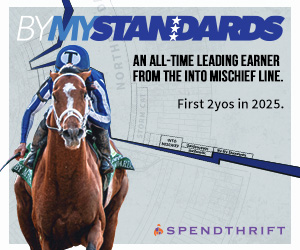
Everyone dreams of owning a champion racehorse but for most of us such animals remain as untouchable as the mythical Pegasus. But horse racing isn’t just the Sport of Kings, it is also the sport of dreamers, of blue collar folk who found greatness in the bargain bin. Former claimers turned heralded champions such as Seabiscuit and John Henry were embraced because of their humble beginnings. After all, who doesn’t love a good “Rocky” story – or a good deal?
How much would you pay for a Triple Crown winner? For Mickey and Karen Taylor, the price was $17,500 and the horse was Seattle Slew. Mickey was a former lumberman and Karen, a flight attendant, who together happened upon a legend. Seattle Slew not only became the first undefeated Triple Crown winner, a Horse of the Year, a champion at ages two, three and four, he was a monster in the breeding shed. It was said that you could breed Slew to a donkey and still wind up with a graded stakes winner. His offspring included A.P. Indy, Swale, Slew O’Gold, Slewpy, Landaluce, Surfside, Capote, Lakeway, and on and on.
Seattle Slew might have been the Deal of the Century for $17,500, but Stymie and Canonero II came straight off the discount rack. Claimed for only $1500 by the masterful trainer Hirsch Jacobs for his wife Ethel, Stymie at first didn’t appear to be much of a bargain, winning only seven of his first fifty starts. After a seven month “vacation” due to World War II, Stymie returned with a vengeance, reeling off nine victories in nineteen starts and earning the award for U.S. Champion Handicap Horse of 1945. The flashy red colt ran with his fine head held high and his out of the clouds running style made him a fan favorite. As did his budget price tag. Stymie wasn’t some blue-blooded six figure Kentucky-bred, he was just an average hard-working joe who could run all day long and never gave up. In his amazing 131 race career, Stymie won thirty-five times and earned over $918,000, making him the world’s leading money-winning Thoroughbred at the time of his retirement in 1949.
Canonero II was a true Cinderella story, a crooked leg colt sold at auction for the budget price of $1200 who shocked the world in the 1971 Kentucky Derby. Owned by Venezuelan manufacturer Pedro Baptista, Canonero II spent most of his two year old season racing rather unimpressively in Venezuela. Nevertheless, Baptista was determined to run him in the Triple Crown races and after a nightmare trip to Kentucky, the colt was sent postward as part of a six-horse betting pool at 8-1. Future Books had listed his odds at 500-1. Languishing in eighteenth place, the overlooked colt somehow threaded his way through the twenty horse stampede and swept to a three and a half-length victory. Surely it was a mistake, there was no way he could reproduce that magic in the Preakness. And yet, he not only won, he did it in track record time. By now, the Triple Crown-hungry public had fallen in love with Cannonero II and despite reports of the colt suffering from exhaustion and illness, made him the favorite for the Belmont. It was not to be. After struggling home fourth in the Test of a Champion, Canonero II was sold to King Ranch for $1.5 million. Voted U.S. Champion Three Year Old Colt of 1971, Canonero II won only one more stakes race – the Stymie Handicap – in which he set a track record while defeating Riva Ridge. Retired with earnings just over $360,000, Canonero II was unimpressive at stud and was eventually sent back to Venezuela where he died in 1981.
If Stymie and Canonero II were discount-priced, then Alsab was Clearance. Costing a mere $700, Alsab might have been short on price but he certainly wasn’t short on starts – racing twenty-two times as a two year old and twenty-three times at three. He won twenty-five of fifty-one starts in such races as the Champagne Stakes, American Derby, Preakness Stakes and Withers Stakes. He was voted U.S. Champion Two Year Old and Three Year Old colt and beat Triple Crown winner Whirlaway two out of the three times they met. He set track records at Washington Park, Suffolk Downs, and Belmont and earned over $350,000. But what Alsab will be most remembered for was his courage. In the final start of his three year old season, the Victory Handicap, he stumbled badly at the start, wrenching an ankle and nearly unseating his rider. Yet he fought on to prevail by three-quarters of length while conceding twelve to twenty-four pounds to his opponents. Like racing’s other bargain horses, Alsab proved that you can’t put a price on heart.
Photo: NYRA Photo, Coglianese Photos, Seattle Slew and Angel Cordero Jr.



